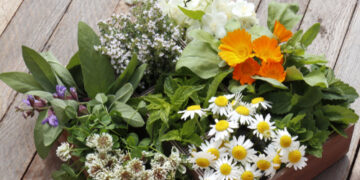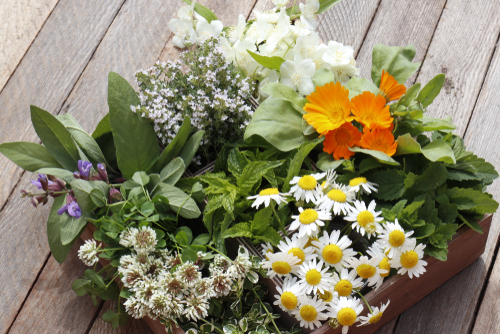A Garden Within Reach
You don’t need a rolling field or rambling garden to grow medicine. A sunlit balcony, a windowsill, a doorstep kissed by morning light—these are enough. Plants have always found a way to thrive in unlikely places, and with a few pots, a handful of soil, and a little patience, you can create your very own apothecary right outside your door.
In times past, every home had a few herbs close by—gathered in baskets, hung to dry in kitchens, steeped into teas or pressed into poultices. That tradition doesn’t require land or luxury. It simply asks for care. With container gardening, even the smallest space becomes fertile ground for healing.
Ad Spot #1
(Insert your first promotional element here.)
Medicine in a Clay Pot
There’s something quietly enchanting about growing your own herbs—not just for flavor, but for wellness. Each plant carries its own purpose and energy. Some soothe the mind, others ease digestion, heal the skin, or strengthen the heart. When you grow them yourself, the connection deepens. You learn their cycles, their scents, the way their leaves curl toward the light.
Container gardening allows these plants to flourish in compact spaces. Pots and raised planters offer flexibility, letting you move plants with the seasons or cluster them together for companionship and beauty.
Before long, your balcony becomes a balm, your window ledge a source of comfort. And from your hands will come teas, salves, tinctures, and meals infused with your own living medicine.
Choosing the Right Companions
Begin with herbs that are easy to grow, resilient, and generous in their gifts. These five are particularly well-suited to container life and home apothecaries:
Chamomile
This dainty flower thrives in pots, needing only sun and well-drained soil. Harvest the blossoms as they open, dry them gently, and steep them into a tea that soothes both stomach and spirit. Chamomile is a soft healer—perfect for easing stress, supporting digestion, and inviting sleep.
Lemon Balm
Bright, citrus-scented leaves that calm the nervous system and lift the mood. Lemon balm loves container life but needs trimming to keep it from sprawling. Its fresh leaves make a wonderful tea, and it dries beautifully for later use.
Calendula
Sun-bright petals with skin-healing powers. Calendula blooms over a long season and does well in large pots with plenty of sun. The flowers can be dried for teas or infused into oils and salves for wounds, rashes, and inflammation.
Thyme
A sturdy, low-growing herb that packs antimicrobial power. Thyme thrives in containers, needing full sun and minimal water. It supports immunity, soothes coughs, and adds warmth to winter teas and syrups.
Tulsi (Holy Basil)
Sacred in many traditions, tulsi is an adaptogen that helps the body cope with stress. With fragrant leaves and a bushy habit, it grows beautifully in pots and offers tea that steadies both mind and heart.
Setting Up Your Container Garden
Growing herbs in containers is beautifully forgiving—especially when you keep a few key principles in mind.
1. Choose the Right Containers
Clay pots breathe, plastic holds moisture, wooden boxes look lovely. Whatever you choose, ensure it has drainage holes. Most herbs dislike wet feet.
2. Use Quality Soil
Herbs prefer light, well-drained soil. A mix of organic potting soil with a bit of compost will nourish them well.
3. Follow the Sun
Most medicinal herbs need at least 6 hours of sunlight daily. A south- or west-facing window, patio, or balcony is ideal.
4. Water Wisely
Let the soil dry slightly between waterings. Morning is the best time to water, so leaves can dry during the day, preventing mildew.
5. Harvest Often
Regular harvesting encourages new growth. Pinch back flowering herbs to keep them leafy, unless you’re collecting blossoms like chamomile or calendula.
Tend your plants like you would a friendship—check in often, offer care, and don’t be afraid to start over if something struggles.
Ad Spot #2
(Insert your second promotional element here.)
Bringing Your Harvest to Life
Once your herbs are thriving, it’s time to begin using them—not just as garnishes, but as everyday allies. A few suggestions for gentle preparations:
-
Teas from fresh or dried lemon balm, chamomile, or tulsi.
-
Salves with calendula-infused oil and beeswax for soothing skin.
-
Steam inhalations with thyme to ease colds and clear the head.
-
Infused vinegars with sprigs of thyme or basil, for culinary and medicinal use.
Start with one or two herbs and grow your knowledge alongside your garden. There’s no rush. Herbalism is, at heart, a slow practice—a conversation between soil, plant, and person.
A Small Garden, A Big Gift
Even the smallest apothecary garden offers something more than medicine. It brings rhythm to the day—watering in the morning, harvesting under soft evening light. It teaches patience and attentiveness. And in the middle of a busy or uncertain life, it offers a patch of green that says: you are rooted, too.
Whether you’re growing on a windowsill or a tiny patio, what matters most is the intention. These herbs will respond to your care. In return, they will offer you calm, nourishment, and healing in ways that go far beyond the cup or salve.
Your apothecary is not just a garden. It’s a way of living—closer to the earth, closer to your own breath, and closer to the quiet kind of wisdom that only plants can teach.
























